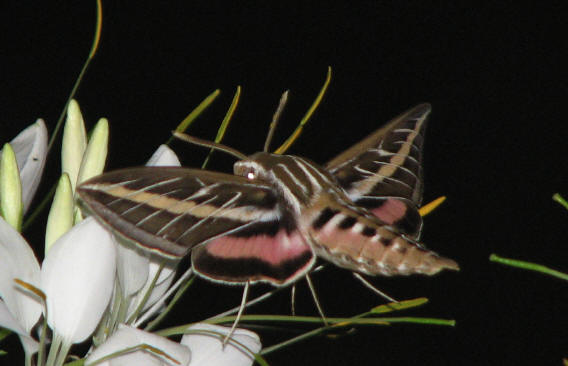|
The Night Life
Pam Van Pelt
Adam's County Master Gardener Program
 As gardeners, we plant trees, shrubs and flowers to attract butterflies, bees and birds. We plant butterfly weed to attract the monarch butterflies, fennel and dill to attract the black swallowtails, berries for the birds and herbs as nectar and pollen for all sorts of bees and butterflies. But, how many of us know what happens in our
gardens when the sun goes down? As gardeners, we plant trees, shrubs and flowers to attract butterflies, bees and birds. We plant butterfly weed to attract the monarch butterflies, fennel and dill to attract the black swallowtails, berries for the birds and herbs as nectar and pollen for all sorts of bees and butterflies. But, how many of us know what happens in our
gardens when the sun goes down?
A couple of years ago, I was outside after dark when I was buzzed by something I thought was a hummingbird. Since it was already dark, I couldn’t imagine why a hummer would be out so late. So, with flashlight in hand, I started searching for this night flying creature. What a surprise to find it was a very large moth feeding on my oriental
lilies and cleome. A quick search on the internet and I found our visitor was a White Lined Sphinx Moth. They prefer white and other pale colored tubular flowers and can hover like a hummingbird while gathering nectar. The hornworm caterpillar of this moth is frequently seen on tomatoes, peppers and grapes and they are often destroyed before they reach the adult stage.
That is unfortunate because they are quite beautiful. The Luna Moth is another night flying creature with incredible beauty. Although the Luna Moth is common, it is not often seen due to its very short life span of about one week.

Luna Moth
Last year, my husband and I were sitting on our back deck one evening just before dark and we witnessed three very young Red Foxes come out of the edge of our woods and into our back yard. Like pups and kittens, they played with each other, chased each other through my flower beds and drank from our birdbath. Many mornings, I would see
broken flowers and I had always blamed it on the rabbits. Little did I know my flower beds were the playground for three fox siblings. Every evening for many weeks, the mother fox would leave the den and cross our field to go into the orchard. Within five minutes all three young ones would be in my backyard. Just like kids, they waited until their mother left before they
ventured out to do some exploring. As the season progressed, they became more wary of us and by the time they were grown, we would only catch glimpses of them. A fox call at night is a very eerie sound, often sounding like a human screaming. Now that we know what it is, we just smile and hope we will see them again.
This summer has been another great treat for us. One evening we were walking around the gardens when I spotted something out of the corner of my eye. I couldn’t imagine what could have climbed a tree in such record speed. We stood very still and something swooped in to our bird feeder. Since it was mostly dark, I didn’t think it would be a
bird and after a while a few more swooped in. They proceeded to the perch that holds sunflower seeds and that is when we discovered our night visitors were Southern Flying Squirrels. We were able to stand less than 10 feet from the tree and observe these interesting little creatures. As long as there were sunflower seeds, they continued to feed regardless of our being
only a few feet away. They have a membrane connecting their front and hind legs. When they leap from a tree, they spread out this membrane and use their wide flat tails as a rudder. They are capable of gliding up to 50 feet. We leave dead trees standing so there are plenty of nesting areas available for these marvelous acrobats. We have seen as many as seven of these
little squirrels at one time and thoroughly enjoy watching and listening to them.
Another visitor we welcome are the bats. Little Brown Bats are Pennsylvania’s most common bat. They are capable of eating huge numbers of moths, mosquitoes, bugs ,beetles and flies. Many people have an unreasonable fear of bats. They may swoop close to you, but their interest is in bugs, not people. Watching them swoop over our deck and
through my flower gardens seeking their dinner is another wonderful treat.
So, the next time you think the day is over and there is nothing to see in the garden, grab a flashlight and a camera and go outside. You’ll be amazed at the "Night Life" just beyond your doors. Read other articles on birds, wildlife & beneficial insects
Read other articles by Pam Van Pelt
|